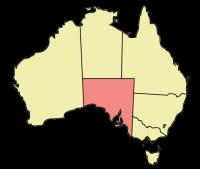|
|
|
South Australia shares borders with all of the mainland states and the Northern Territory. It is bordered to the west by :Western Australia, to the north by the Northern Territory, to the north-east by Queensland, to the east by New South Wales, to the south-east by Victoria, and to the south by the Great Australian Bight and the Indian Ocean. With over 1.6 million people, the state comprises less than 8% of the Australian population and ranks fifth in population among the states and territories. The majority of its people reside in the state capital, Adelaide, with most of the remainder settled in fertile areas along the south-eastern coast and River Murray. The state's origins are unique in Australia as a freely settled, planned British province, rather than as a convict settlement. Official settlement began on 28 December 1836, when the colony was proclaimed at The Old Gum Tree by Governor John Hindmarsh. The first settlement to be established was Kingscote, Kangaroo Island, on 26 July 1836, five months before Adelaide was founded. The guiding principle behind settlement was that of systematic colonisation, a theory espoused by Edward Gibbon Wakefield that was later employed by the New Zealand Company. The aim was to establish the province as a centre of civilisation for free immigrants, promising civil liberties and religious tolerance. Although its history is marked by economic hardship, South Australia has remained politically innovative and culturally vibrant. Today, the state is known as a state of festivals and of fine wine. The state's economy centres on the agricultural, manufacturing and mining industries and has an increasingly significant finance sector as well. |




 RSS
RSS










